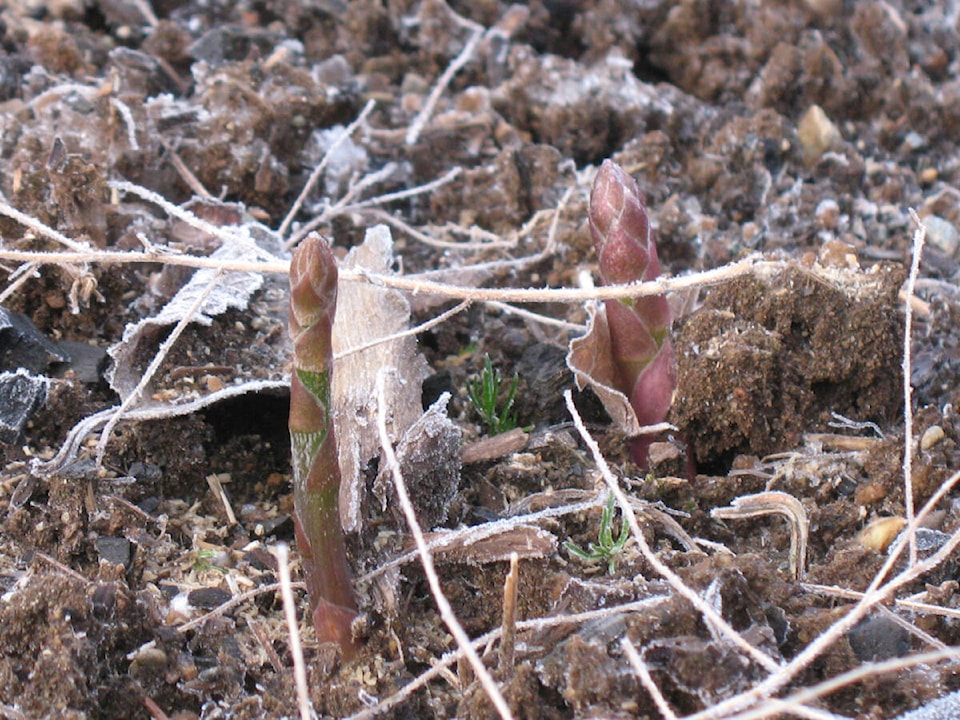By Mary Lowther
David insists that he knew he had been “selected” when I showed up the week after we started dating, brandishing a shovel. As he tells it, I arrived early one morning while he and some other hospital workers were unwinding after a night shift.
“Don’t get up,” he quotes me. “I’m just here to plant some asparagus in the back yard,” and off I went. According to David, while the next hand was being dealt he explained that we had recently met. There was a brief silence while they considered their cards, until the dealer spoke.
“One club,” she said. “Twenty dollars says you’ll be meeting her parents by the weekend.” She then explained that asparagus takes a couple of years to produce the first delectable spears and left David to consider the implications.
Since I had already gone outside, I am unable to confirm or deny the story, but my memory is that I simply couldn’t resist cultivating his large (and entirely untilled) back yard. The visit to my parents the next evening was entirely coincidental. Whatever the facts of the case may be, when we sold that house 10 years later we did dig out a clump of my mother’s snowdrops I had planted for sentimental reasons, along with that asparagus, to replant in Mesachie Lake. The reader may draw their own conclusions. Whatever those may be, it goes without saying that we anticipate this time of year as eagerly as the children do, except we know the Easter Bunny would never share his eggs with us if they were made of fresh asparagus instead of mere chocolate.
Whatever we tell the children, it’s that time of year. The first bed I transplanted into my huge new garden was (unsurprisingly) asparagus, and has finally begun sprouting fat, juicy, delicious little spears. I’ll wait till they’re a foot tall, then hold the top few inches and bend the stalk over until it breaks, leaving the woody lower portion in the ground. I’ll only harvest spears as thick as the digit traditionally used when discussing politics, leaving the rest to develop fronds that feed roots for next year.
In my previous patch I wanted to develop more plants to fill our present three by 60 foot bed, so I allowed two female plants to go to seed and then let their offspring develop. When I dug all the plants out last year, I also divided some others that had formed an extra cluster or two of roots, ending up with two rows along the whole length of the bed with a few extra plants left over for elsewhere.
David feels that one can never have too much asparagus, so I plan on filling up a second bed as soon as he prepares it. I will stagger the pants to stand two feet apart. Jim Motes, vegetable specialist at Oklahoma State University, found that no matter how deeply he planted asparagus roots they all eventually moved to four inches deep, and recommends planting them at that depth, regardless of traditional lore. I followed his advice with excellent results. Before planting I did a soil test that revealed the bed was deficient of most minerals, but not too acidic, so I added half an inch of composted chicken manure, a quarter of an inch of compost and dry organic fertilizer at the rate of one litre per hundred square feet.
I dug a four-inch deep hole for each root cluster and added another quarter cup of fertilizer to the soil beneath each hole. I filled the holes with water and quickly planted each root, trying not to think of them as the giant spiders they uncannily resemble. I didn’t add any mulch last year, but plan on doing so once the soil dries out. I won’t put any on sooner because the nice damp conditions might attract slugs that prefer a free meal of asparagus tips to other seasonal treats.
Roger Swain, host of PBS’s Victory Garden, recommends sawdust as a mulch, but local wood contains too much potassium, throwing out the mineral balance of our soil. Consequently, I use straw grown in the drier climes of the B.C. Interior, where they have less rain to wash the nutrients from the soil. This is also the reason why I ask what the animals eat when I’m buying manure; if we keep adding mulch and manure rich in potassium, our soils will become imbalanced and produce weaker crops. Ranchers who care about their stock know they need a balanced diet if they are to breed, and therefore often import hay from the mainland.
Nineteenth century market gardeners spread sea salt on asparagus soil, and since gardening expert Steve Solomon has tested and recommends it, I’ll try it this year at the rate of half a cup per 10 square metres. Solomon writes that this amount of salt won’t harm the soil and results in tastier spears.
The reader, or hopefully readers, might notice I use a lot of advice provided from other gardeners through their various writings. This might lead one to assume I have a vast library of such works, but I am painfully aware that there are many wonderful volumes I have not yet been introduced to. If you have a particular gardening book to recommend I am always grateful to find another, thank you.
Please contact mary_lowther@yahoo.ca with questions and suggestions since I need all the help I can get.
